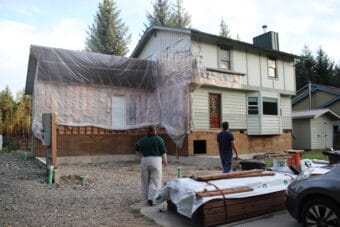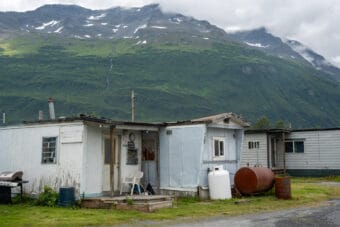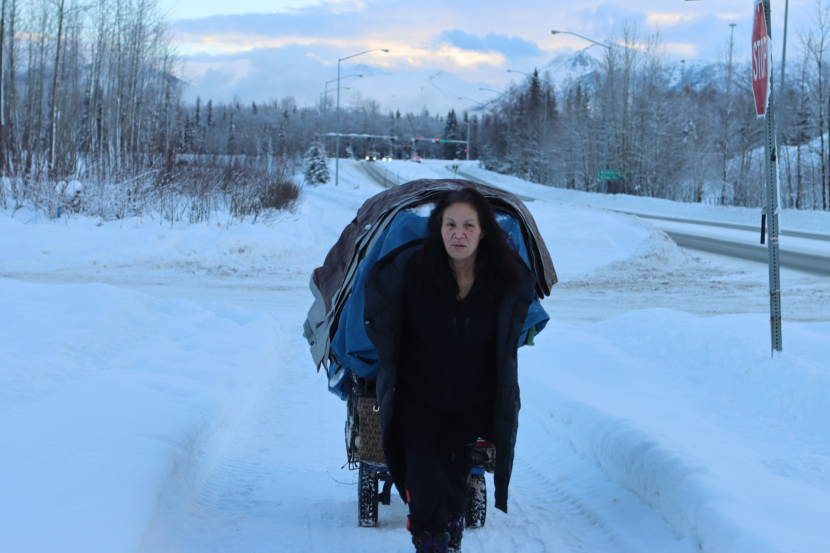
It’s a relatively balmy 25 degrees as Lucille Williams drags a cart down a bike path in Anchorage’s Mountain View neighborhood.
The temperatures have turned the snow into mush in some spots, leaving Williams out of breath. On top of the cart is a repurposed dog kennel filled with pots and pans, blankets, tarps, and other items.
“What we have is kind of what we really own, which is barely anything,” she said, stopping for a breath.
Williams, 46, said her body hurts from living in the streets and shivering through Anchorage’s winter temperatures. She has a bruise under each eye – she doesn’t say why.
She’s exhausted, but needs to get to her next campsite – about a quarter mile away in another city park – before city workers come and clear out her current home. As part of the city’s abatement program, workers from the parks department stapled a paper notice on a tree near her old camp warning her she had ten days to move.
The program has existed for years in the summer, but starting in late December, for the first time Anchorage started removing homeless camps on public property during the winter months. The Anchorage Parks and Recreation Department says it’s cleared more than 50 camps since Dec. 22.
Policy makers say it will pressure campers into shelter or housing, where they’ll be safer and have more direct access to services.
“Winter abatement is — should be that gentle nudge, to get people to some type of situation where they can get help, they can get assistance,” said Midtown Assembly member Felix Rivera.
He supported allocating about $650,000 from the city’s alcohol tax revenues towards clearing camps.
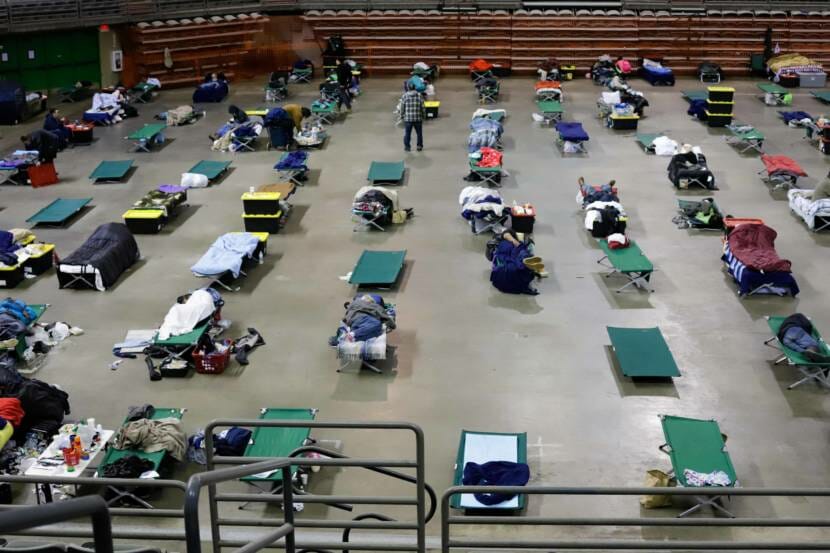
But advocates are raising concerns about the city’s approach and they say the city is failing to provide viable alternatives to camping.
“We just don’t have units available,” said Jessica Parks, who oversees housing for RurAL CAP, one of the nonprofits that does direct outreach to campers. “And if we do have units available, they’re not always the appropriate types of units.”
Williams said she doesn’t plan on moving to shelter, despite the outreach from RurAL CAP and over 100 open beds at the Sullivan Arena, the city’s main shelter. She’s been in it before, but prefers the open air.
“There’s a lot of issues (in shelter), a lot of people stealing and they only give you so much that you can bring,” she said. “And then there’s the whole COVID thing.”
Some campers are drug users or have PTS, which can makes it hard to live in a shelter alongside more than 400 people. Others are banned from returning to the Sullivan and other shelters.
By law, the city is required to have open space at the shelters before it can remove a camp. That kept the city from clearing camps in October, November and December, when the Sullivan was mostly at or above capacity.
In late December, the city raised the capacity at the Sullivan by about 100 people. It’s unclear what changes the operator made to accommodate the extra people. The city hasn’t followed up on a request to tour the facility and to speak with the city’s main homelessness coordinator, Dave D’Amato, which Alaska Public Media made on Jan. 10.
Residents have long complained about cold temperatures at night in the arena, and broken-down bathrooms, which have forced residents to use porta potties since last summer.
The current living situation at the Sullivan isn’t desirable for many people without permanent homes, advocates say.
“Gosh, sharing a bathroom is really hard with two teenage kids, and you can just amplify that issue when you’re housing … 510 people at the Sullivan Arena,” said Owen Hutchinson, a spokesperson for the Anchorage Coalition to End Homelessness, which coordinates outreach for the city’s abatement program.
That means that many residents who don’t want to be in shelter are just moving from one illegal camp site to another.
“It’s a shell game,” said Parks, from RurAL CAP, “You’re just clearing one camp out, and they’re just moving and setting up a camp somewhere else.”
Outreach workers sometimes help campers move, part of a process of establishing rapport with campers in hopes that some day they’ll be ready to look for housing. Jerry Staten is one of the workers.
Each weekday he travels around town on a predetermined route of known campsites. He brings cigarettes, sandwiches and blankets and knows many campers by their first names.

Often, he’s joined by other social workers who help campers sign up for Medicaid or food stamps. If campers are interested, Staten says he’ll help them get clean clothes and even set up a job interview. He’ll also sign them up for coordinated entry, a waiting list for housing that prioritizes the most vulnerable campers coordinated by the Anchorage Coalition to End Homelessness.
But getting on the coordinated entry list isn’t a guarantee that campers will be housed in the near future because of the housing shortage and nuances of eligibility.
“If you go out there and say, ‘Hey, sign up, if you talk to me and I’ll get your housed,’ — That’s a promise that you can’t make,” Staten said.
In some ways, the problems are the same ones the city has had for years. The difference, advocates say, is that during the winter months, campers face significant risks of frostbite each time they’re forced to move.
Campers often spend weeks in the fall winterizing their camps by building platforms from wood pallets, draping tarps over their tents and installing foam insulation on the walls and floors.
Brian Vaughn, who camps with the same group as Lucille Williams in Mountain View, recently had his camp removed.
One morning last week, he found himself shivering in a bare-floored tent in a park in Mountain View. It’s nearly the exact spot where he had a tent in the fall before it was removed in September. Vaughn appealed because there wasn’t enough space at the Sullivan for all the campers at the time, and he thinks the city won’t bother him now that he’s moved back during his appeal.
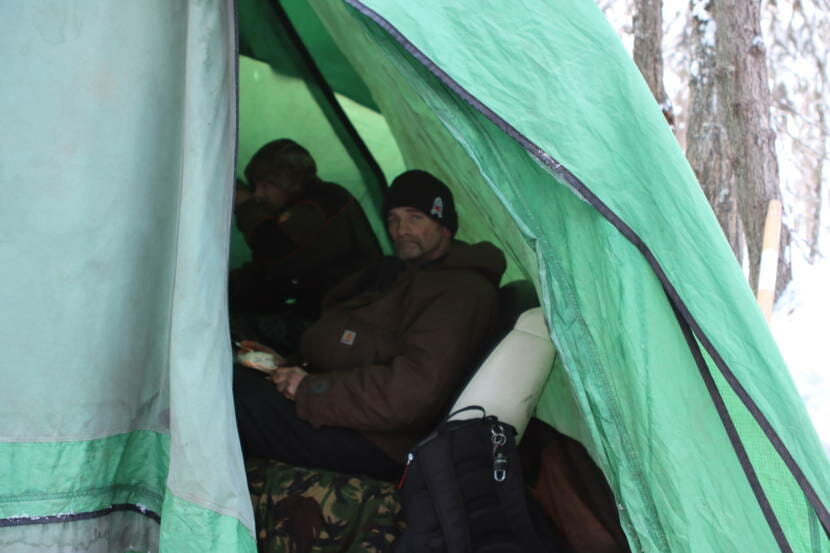
He’s lost supplies during the last removal, including tents. The zipper on the current tent door is ripped, and several other fellow campers are bundled up next to him.
“It’s hard because we normally were supposed to have a few months ago been getting set up for the winter doing the improvements for the cold weather,” he said. “Now we’re up on the move again, sitting here on a plate of ice.”
Within a few days, the camp is filled with supplies draped over with tarps for insulation. Campers insist that their possessions are legally acquired, though sometimes Parks and Rec staff throw away items they deem as junk.
“We kept telling them ‘This stuff’s not garbage, stop taking it,’” Vaughn said. “And they laugh at us about it.”
Parks and Rec say they do their best to make removals as easy and safe as possible for campers by working closely with campers and coordinating around the weather.
“If it’s raining, for instance, and we can look at the forecast and see that tomorrow is better if it’s snowing, or if it’s just freezing cold,” said Mike Braniff, who coordinates camp removals for Parks and Rec. “The one thing we don’t want to do is jeopardize the safety of the campers to stick to a timeline. So we’re certainly adaptive.”
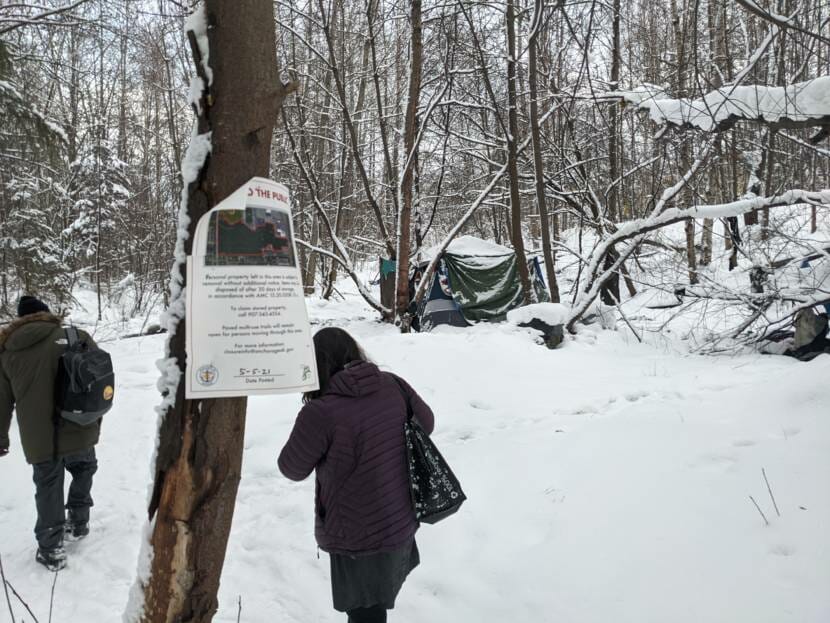
Braniff said that decisions about when and where to remove camps are often made for public safety reasons — both for the campers and neighbors. Camps can pose fire risks in some areas, and Braniff says camping in school routes has been an issue.
“Whether it’s right next to a highway or – gosh, there’s been a number of situations with structures that have been unsafe,” he said. “We’re addressing it for that reason as well.”
Some advocates and Assembly members have raised concerns about confusing communication from the city about clearing camps, which has made it unnecessarily hard for campers.
The city didn’t announce publicly that it had started removing camps in winter until an Assembly Housing committee on Wednesday, where city manager Amy Demboski said it was happening “on a limited basis” in certain neighborhoods, with a priority on public safety.
She said that follow up questions from the Assembly needed to be submitted in writing.
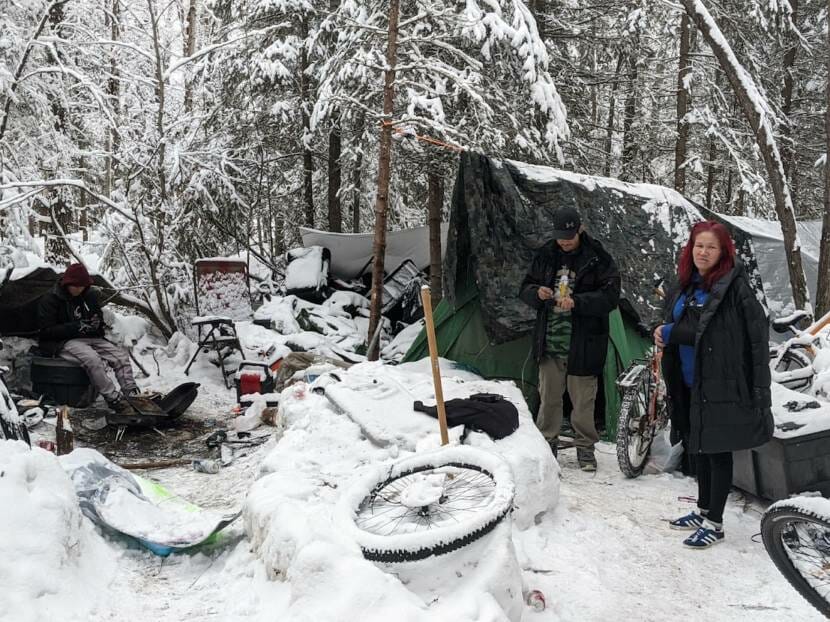
Advocates said the city never stopped posting abatement notices at campsites when the Sullivan was above capacity, something that Braniff with Parks and Rec denied. RurAL CAP, Covenant House, and the Anchorage Coalition to End Homelessness say that notices were posted around campsites in November and December, even though camps were never cleared.
Parks, with RurAL CAP, said that affected the relationship that outreach workers had with campers.
“When we can’t even give them some certainty over the information that we have it really does undermine some of that trust,” she said.
For people like Williams, camping is worth it, even with the added risk of having her camp cleared. It’s what she’s used to and she doesn’t have to worry about anybody except for those in her group.
“This became like our comfort place, like we’ve been okay out here,” she said. “It’s just us – we don’t bother nobody.”


